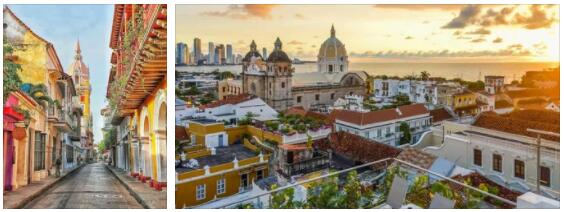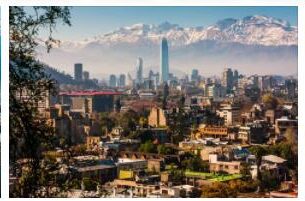Buenaventura (Colombia)
Buenaventura is Colombia ‘s main Pacific port. It is located on the shore of the bay of the same name. The name of the city means “beautiful view” in Spanish. Buenaventura was founded in 1545 by the Spaniards. From the city port to Malaga Bay, which is located to the north, stretches a string of beaches: Guachadito (one of the best in the region), secluded Boca Veigia (accessible only by boat), Terquito (you can surf), Termales (there are several hot springs) and Verde (you can visit here accessible only by boat). Pacific beaches and coastal waters are different from the Caribbean. On this coast, the sand is darker, the beaches are surrounded by tropical forests, some beaches are difficult to access, as the coast is overgrown with mangroves, there are strong ebbs and flows, the bottom is mostly rocky, and the coastal waters are less salty, as numerous rivers flowing here, originating in Andes, and cooler ones. Tidal forces are the cause of fairly high waves. For vacationers, this can become an obstacle to swimming, but for surfers, this will only be ”
To the north of Buenaventura are the resort towns of La Bocana, Nucuy, El Valle and Baio Solano. In these places, in addition to a beach holiday, you can go diving, fishing and surfing. The most suitable time for diving is April-May, when flocks of sardines come to the coast, and from July to October, humpback whales and dolphins come to the local waters to mate. The best place for whale watching is the Ensenada de Utra National Park, located near Nukui. Fishing season starts on the Pacific coast between May and June. Here you can catch fish such as dorado, flying fish, blue marlin, swordfish, tuna and snapper.
Approximately 150 km southwest of Buenaventura, the Gorgon and Gorgonilla Islands are located in the ocean. Once there was a prison here, and in 1985 the islands were declared a national park. The area of the park is 486 sq. km. From July to October flocks of humpback whales, dolphins and sharks swim north along its shores. You can also see many turtles in the park. The diverse underwater world of the national park attracts diving and snorkeling enthusiasts.
At 500 km from Buenaventura Bay in the Pacific Ocean, the small rocky island of Malpelo (area 0.35 sq. km) is of interest. This is the westernmost point in Colombia.. The island is uninhabited, there is only a military post of the Colombian army on it. Malpelo is considered one of the best dive sites in the world. Its coastal waters are home to a wide variety of shark species (silky sharks, frilled sharks, whale sharks, hammerhead sharks, sharptooth sand sharks), rays and tropical fish. Diving on Malpelo Island is more suitable for advanced tourists.
Cartagena (Colombia)
According to politicsezine, the historic city of Cartagena is located 192 km west of Santa Marta. It was founded in 1537 and was one of the main ports of New Granada. From here, the gold and silver mined in the colony was exported to Europe. That is why Cartagena was often attacked by pirates, such as the famous English pirate Francis Drake. To protect the city on the coastal islands and capes, a whole network of powerful fortifications was built, the total length of which was more than 11 km.
The most interesting Old Town Cartagena (Ciudat-Amurallado), which is located in its northern part. It is here that ancient forts and numerous colonial buildings are located. Ciudat Amurallado is divided into four zones: San Diego, La Matuna, Santo Domingo and Getsemani. In the Getsemani area is the main fortress of Cartagena – Castillo de San Felipe de Barajas, whose walls are 12 meters thick. Its construction was carried out from 1533 to 1657. Also in the Old Town there is a vast Central Park (1911) and the oldest church in the city – Iglesia de Santo Domingo (1536).
In the southern part of Cartagena are residential areas. The center of this area is San Pedro Claver Square, on which stands the Cathedral (1575-1602). Nearby is Bolivar Square with a monument to the first president Columbia, the Archaeological Museum and the Palace of the Inquisition (1770). Also in Cartagena, it is worth visiting the former Las Bovedas prison of the 16th century, which now houses an extensive trading area, the Conventa de La Popa convent of the 16th century (now the Historical Museum), the Old Port and the promenade with chic villas and restaurants. South of the Getsemani district on the peninsula is the Bocagrande recreation area. Here, sandy beaches stretch along the coast, along which there are hotels, restaurants, bars and discos. However, those who want to relax on quiet picturesque beaches away from the bustle of the city should go to the protected islands of Rosario and San Bernardo located 40 km south of Cartagena, or to the island of Baru. The Rosario and San Bernardo Islands National Park is the country’s only underwater park. It covers an area of 19500 hectares. Its main attraction is the underwater world, which attracts diving and snorkeling enthusiasts from all over the world. In coastal waters, you can see a variety of corals (mostly soft corals), sponges, mollusks, crustaceans and fish (parrotfish, angelfish, butterflyfish, snapper, groupers, surgeonfish, tuna and barrkuda). Local dive sites are suitable not only for experienced divers, but also for beginners. The main infrastructure of the National Park is located on Isla Grande. Diving is also possible in the vicinity of the nearby island of Baru, which is surrounded by coral gardens.
Another 40 km south of the islands of Rosario and San Bernardo on the coast lies Morroskillo Bay with the archipelago of the same name. Its Keizen, Tintipan and Mukura Islands are surrounded by some of the most beautiful coral reefs and are home to cat sharks, dolphins, turtles and a variety of tropical fish.



